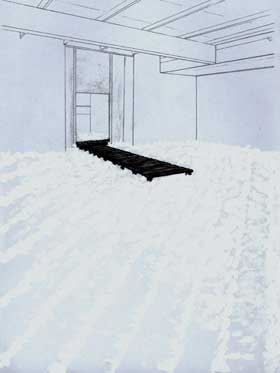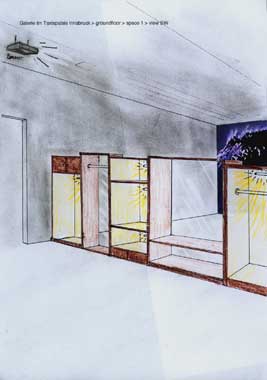| |
|||||
|
|
Martin
Gostner Seitlich aus der Requisite kommend / Coming Out Of The Props Sideways February 1 – March 24, 2002 |
||||
| |
|||||
|
|
||||
| |
|||||
| Opening Thursday, January 31, 2002, 7 p.m. Exhibition will be opened by Günther Platter Matthias Herrmann will speak about the exhibition |
|||||
| |
|||||
|
Martin Gostner shows recent and all new works in this extensive solo exhibition, which are seen for the first time in Innsbruck. Four installations were conceived especially for the rooms of the Gallery in Taxispalais. He developed or transformed two other recent works specifically for this location. With the title "Coming
Out of the Props Sideways", Martin Gostner uses a metaphor from the
realm of theater or film, which stands for his artistic work and, at
the same time, also describes his own position, which nevertheless
relates in a broader sense to the viewer in general. In the context of
his elaborated and symbolically charged scenarios, Gostner sees himself
as the protagonist of a "play", in which, as he says, he tries out his
skill "in the symbiosis of actor, author, director, producer and even
his own critic." In these different roles and functions, he confronts
himself with the various facets of his personality, his (artistic)
self, which he challenges reflectively and critically: "Every day you
put on a mask, try to remember your lines for today, try as the
director to get the other actors on the set at the right time with the
right text, in order to make your entrance then at the right moment,
coming out of the props sideways." In "Was du suchst, sucht nach dir" ("What You Are Looking For, Is Looking For You"), the path leads past a wall of used cupboards with open doors. The interior of the cupboards is partially furnished with lamps that shine outward. Some of them have no lighting, but glass backs revealing a large video that is projected onto the back wall of the room, parallel to the cupboard wall. This video, which is continuously visible along the top, shows a tsunami, a gigantic seismic sea wave crashing into the space with dangerous violence. Here Gostner registers exactly the moment of remembrance of a primary experience, when curiosity and the simultaneous search for shelter turn into fascination and terror. In the adjacent room, the work "zu breit, zu weit" ("too broad, too wide") continues this theme. A fragment of an air mattress lies like flotsam and jetsam cast upon the shore in a puddle of silicone, partly entangled in a web of hot glue, a "prop of failure" (Gostner), where the protagonist remains in the off. "zu breit, zu weit" forms a passage-like transition to the next room, where the scenario of unfathomable terror is followed by a staging of the concretely vulgar terror of everyday life. In the poster photo work "Promenade des Autrichiens" and the video "Über'm Pfandl", Gostner depicts a real-fictive, political review of the post-war history of Austria. This climaxes in reference to a topical political milieu in the vandalizing of a shabby room (belonging to a "foreigner"?), located above the (imaginary) Viennese inn "Kupferpfandl". Gostner reconstructed a series of posters for this inn, for events that could have taken place there since 1945. The posters highlight the historic milestones of the 2nd Republic, transport the mood of post-war Austria, national sentimentality and resentment, party-political and ideological convictions of the spirit of the times in word and writing in their respectively lapidary and seemingly plausible form. Their historical precision and simultaneous wit succeed in tearing open "homeland" chasms. It is a matter of "recapitulating the past, so that we do not have to capitulate to the present." (Gostner) In "Ansichten der Gegend um Clausewitz" ("Views of the Area Around Clausewitz"), the stage of conflicts is shifted to the abstract level of strategic planning. All four walls of the room are covered with drawings that Gostner has applied with charcoal. They are plan sketches of historical battles, aesthetic manifestations and simultaneously models that were developed for war as a specific form for organizing contrary political interests and violence. The work "dicke Aura Heimat" ("thick aura homeland") compresses a segment of the typical Austrian culture of gastronomy furnishings, along with the equally typical dish eaten on them: Gostner coats a simple restaurant table and two concomitant benches with the fried crust of flour, eggs and breadcrumbs that is used for Wiener Schnitzel. In the lower level of the gallery, in the glass-covered hall and the foyer, Gostner has installed the work "Der große Server" ("The Large Server"), in which he reverts to the material of cotton wool, to which he ascribes specific meanings in his work. For him, cotton wool represents that which is "soft", "pliable", which he conjoins with that which is "historically imprecise in both official history and personal memory". The cotton wool covering the floor, which can be walked over in parts on a wooden pier, functions as an imaginary reservoir of memory and the shapes that are virtually contained in the material. For Gostner, the sensuous and associatively highly charged material of cotton wool forms a "morphological alphabet", which contains his "store of tools" – in terms of both language and form.
|
|||||
| |
|||||
|
Martin Gostner
|
|||||
| |
|||||
|
Catalogue
presentation Catalogue |
|||||
| |
|||||
|


